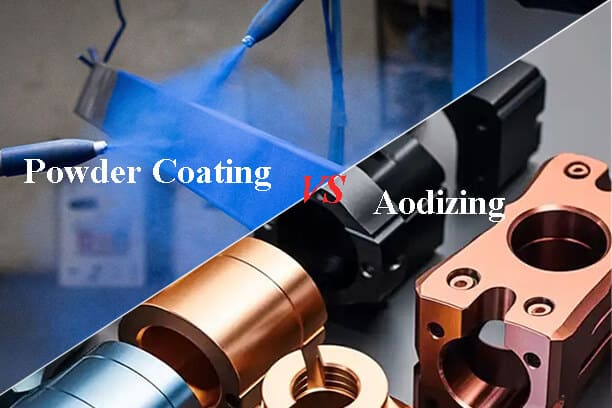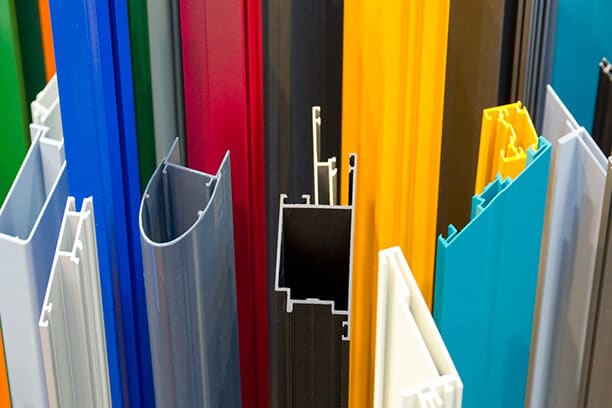Powder coating and anodizing are two common surface treatments used to enhance the performance, durability, corrosion resistance, and visual appeal of CNC machining aluminum parts. However, what are the differences between the two, and how to choose the right one for the specific application?
This article will explore the difference between the two surface finishing methods, along with powder coated and anodized aluminum, and factors to consider when choosing between anodized and powder coat finishes, guiding you in selecting the exact one best suited for your project.
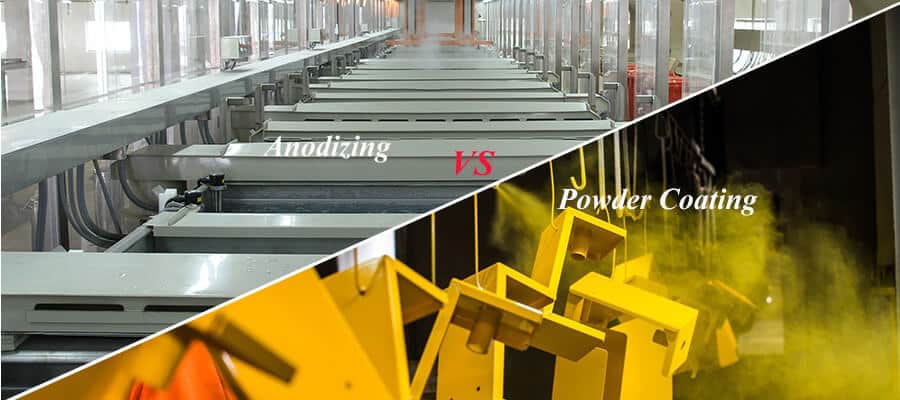
Understanding Anodizing and Powder Coating
What is Powder Coating?
Powder coating involves applying positively charged powder onto a grounded object using electrostatics. The coated object is then heated to achieve melting and flow, resulting in a resilient and smooth layer known as an organic finish. The powder coat formed is highly durable, offering excellent resistance against corrosion and protection against ultraviolet (UV) light. This versatile technique can be applied to a wide range of materials, including metals, wood, plastic, glass, composites, and medium-density fiberboard (MDF).
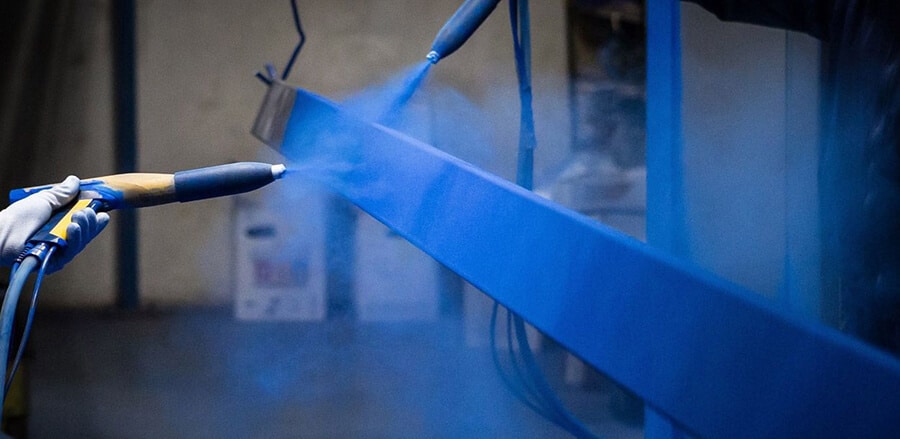
Advantages of Powder Coating
- Enhance the corrosion resistance of aluminum components.
- Transform the appearance of raw materials sourced from mills, which tend to have a lackluster appearance.
- Provide protection against wear and tear for aluminum parts.
- Conceal dye marks resulting from the mill finish process, ensuring a smooth and even surface.
- Improve material reflectivity and hardness.
- Suitable for application on any metal that can withstand the required curing temperatures, including aluminum and other commonly used metals in the construction industry.
- An economical coating method that is both durable and cost-effective, making it an ideal choice for large-scale coverage.
Disadvantages of Powder Coating
- Prone to chipping: Due to the lack of integration with the substrate, the applied coating may be susceptible to chipping. Consequently, it may be less preferred in industries that require heavy-duty applications.
- Susceptible to sunlight: The applied coating is vulnerable to prolonged UV exposure. Nevertheless, it still offers considerably greater resilience compared to traditional paint solutions.
What is Anodizing?
Anodizing refers to an electrochemical process utilized to generate a protective oxide coating on a metal surface. What differentiates anodizing from other finishing methods is its unique approach of utilizing the existing material instead of introducing new material for coating purposes. This feature ensures that anodized coatings do not peel or flake, resulting in exceptionally durable metal surfaces.
Anodizing is greatly suitable for applications where superior corrosion and abrasion resistance are crucial. In addition, anodizing imparts non-conductivity to metal surfaces, which can prove beneficial in specific situations. It is important to note that anodizing is predominantly limited to aluminum substrates.
Advantages of Anodizing
- Enhance the resistance to abrasion and corrosion of machined parts, thus prolonging their lifespan.
- Enhance the non-conductive properties of machined parts.
- The oxide film developed through anodizing is generally stronger than a powder coat, providing robust protection against varying weather conditions.
- Anodized parts tend to be easily maintained and cleaned.
- Offer excellent resistance against damage and degradation caused by UV light.
- Suitable for products that receive constant public use, such as doors, due to its high resistance to contact and abuse.
- Submerging the metal in an electrolyte bath ensures the creation of a remarkably consistent surface, eliminating concerns about missed areas or uneven coverage.
Disadvantages of Anodizing
- Higher cost: Anodization is generally more expensive compared to powder coating.
- Limited color options: Although anodization offers a range of color possibilities, it is not as versatile as powder coating in terms of color selection.
- Increased visibility of pre-existing imperfections: The exceptional uniformity achieved through anodization may make any prior imperfections on the metal surface more noticeable.
- Limited chemical resistance of anodized machined parts.
- Color variation due to the translucence of the coating.
Powder Coating vs Anodizing: Their Difference
1. Process
Anodizing is an electrochemical process that involves strengthening and thickening the natural oxide coating on a metal surface. In contrast, powder coating is an electrostatic process wherein dry powder, charged electrostatically, is sprayed onto the surface for coating.
In general, anodizing is mainly applicable to aluminum substrates. It is not feasible to anodize stainless steel and similar metals as they do not naturally develop the required oxide layer for anodizing process.
2. Coating Formed
The primary difference between anodizing and powder coating lies in the coatings formed. Powder coating is an organic coating, or a coating containing carbon, while anodizing forms a metal oxide coating.
3. Base Material
Anodizing is usually limited to aluminum products, whereas powder coating can be applied to a wide range of surfaces, including steel, wood, composites, and others.
4. Color Options
Powder coating provides an extensive selection of color options, as it allows for the creation of custom colors through the mixing of various pigments. This flexibility makes it easier to achieve a precise color match, which is greatly suitable for architectural and decorative applications where color coordination is critical.
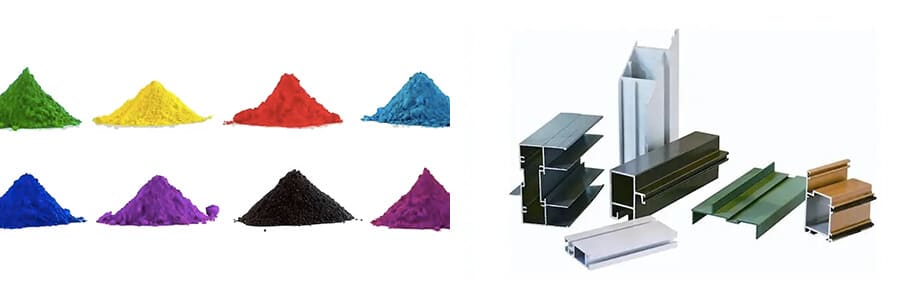
On the other hand, anodizing offers a significantly limited range of colors, including options like black, gold, bronze, and so on. The choice of color in anodizing is also influenced by the specific material being anodized.
5. Color Variation
Anodizing exhibits shade variations between different batches, whereas powder coating ensures consistent and uniform color, without any variations in shade between batches.
6. Surface Finish
Anodizing can offer clear and satin finishes, while powder coating provides a range of options, including matt, satin, gloss, super matt, gloss, and textured finishes. In certain cases, clear powder coating can be applied to preserve the original appearance of the workpiece while improving its durability.
The uniformity of an anodized finish has a tendency to accentuate any irregularities or flaws in the base metal. This is generally not an issue with powder coating, as it has the ability to mask surface imperfections and create a uniform finish.
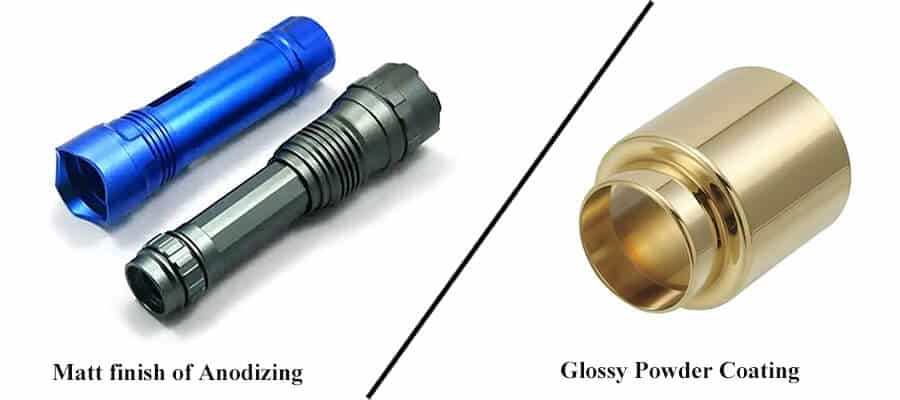
7. Cost
The expense of anodizing and powder coating can differ greatly, influenced by factors including the size and intricacy of the parts, the equipment used, the materials employed, and the overall scale of the process.
Typically, anodizing involves higher costs than powder coating.
8. Versatility
Powder coating offers extensive color selection and compatibility with a wide range of materials, while anodizing has a limited variety of color options, and in most cases, it can only be applied to aluminum.
9. Durability
Anodizing forms a durable and permanent protective layer on metal surfaces, providing resistance against fading or damage caused by external factors like heat, sunlight, and moisture.
Conversely, powder coatings are relatively more susceptible to damage from external weather conditions and may exhibit cracking or peeling over time when exposed to moisture, sunlight, or humidity.
10. Strength
Anodized components have greater hardness compared to those that are powder coated.
11. Lifespan
Anodized components exhibit a longer lifespan than objects with a powder-coated finish.
12. Corrosion Resistance
Both powder coating and anodizing provide effective corrosion resistance, but anodizing proves to be the superior option. The anodized layer acts as a protective barrier, effectively preventing the infiltration of moisture and other corrosive elements, making it suitable for outdoor applications where exposure to harsh environmental conditions is a concern.
13. Wear and Abrasion Resistance
Anodized components offer exceptional resistance to wear and abrasion, making them durable and easy to clean and maintain. In contrast, powder coating does not provide the same level of wear and abrasion resistance as anodizing.
14. Surface Visibility
Anodizing does not hide or conceal weld joints, while powder coating effectively covers and masks them.
15. Sustainability
Anodized materials can be recycled directly without the need for coating removal. The recycled product retains the same properties as the original one. However, powder coating must be removed before starting the recycling process.
16. Environment Friendly
Both powder coating and anodization are environmentally friendly practices. Powder coating generates minimal waste and releases negligible amounts of volatile organic compounds (VOCs). Similarly, anodization is chemically stable and non-toxic.
17. Applications
Anodized aluminum products are commonly employed in high-traffic areas and applications that involve persistent usage, making them more durable and resistant to wear and tear. On the other hand, powder-coated products are generally not the top choice for heavy-traffic areas.
18. Repair or Repaint
Anodizing lacks the ability to undergo repairs, dents, or repainting. To safeguard anodized aluminum products during construction, they may require wrapping or other forms of protection.
In contrast, powder-coated products can be easily repainted as necessary, while still maintaining their original color and texture even after repairs have been made.
Anodized Aluminum vs Powder Coated Aluminum
Anodizing aluminum produces an oxide layer that is exceptionally tough and highly resistant to wear, resulting in anodized coatings that are stronger and more durable compared to powder coatings.
Anodized aluminum products tend to offer a longer lifespan than powder coated products, as anodizing provides enhanced resistance against external elements like sunlight, oxidation, and moisture that can lead to wear and tear.
The hardness of anodized coatings can be further enhanced by strengthening the thickness of the oxide layer or opting for a harder anodizing solution.
| Type of Anodizing | Features |
| Chromic Acid | Chromic acid baths are used to form a thin layer of metal oxide on the surface of the anode (workpiece). This method is widely employed as an extension of the chrome plating process and is one of the earliest forms of anodizing. However, this process has traditionally relied on the use of hexavalent chromium, which is a well-known carcinogen. As a result, alternatives such as trivalent chromium or boric acid are now being employed in order to mitigate the associated health risks. |
| Boric Acid | Anodizing boric acid serves as a viable substitute for chromic acid, offering a safer and less toxic solution without compromising the desired outcomes. Despite being a safer and more efficient acid compared to chromic acid, the broader implementation of boric acid anodizing has faced some challenges due to its status as a patented process. |
| Sulfuric Acid | Sulfuric acid, which doubles as the electrolyte for hardcoat anodizing, is employed to produce Type 2 anodizing, resulting in the formation of a thicker oxide coating. Notably, this thicker coating also diminishes the electrical conductivity of the aluminum, which can be useful for specific applications of the parts. |
| Hardcoat Anodize | Hardcoat anodization is a refined version of sulfuric acid anodization that involves stricter process controls and increased immersion times. It offers the flexibility to incorporate various materials such as polytetrafluoroethylene (PTFE) molecules, enabling it to make a lubricated surface with enhanced slipperiness. |
Anodized aluminum can be recycled without requiring coating removal, preserving the same properties as the original aluminum. Conversely, when recycling power-coated aluminum, it needs to first remove the coating from the aluminum workpiece.
| Anodized Aluminum | Powder Coated Aluminum |
| Higher strength | Lower strength |
| Can be recycled directly | Recycling requires coat removal |
| Limited range of application | A broad range of application |
| Relatively higher hardness | Relatively lower hardness |
| Longer lifespan | Relatively shorter lifespan |
Factors to Consider When Choosing Between Powder Coating and Anodizing
The choice between powder coating and anodizing will be determined by the specific requirements of the application. Nevertheless, there are five main factors that you might need to take into account.
Cost
The cost of powder coating can vary based on factors such as the size of the workpiece, the type of powder utilized, and the number of coats applied. Despite this variability, powder coating generally tends to be more cost-effective when compared to anodizing. In addition, both processes necessitate surface treatment, with sandblasting often employed prior to powder coating to eliminate impurities.
In contrast, anodizing is a cost-consuming process due to the requirement for specialized equipment and higher electricity consumption. Despite the additional cost, anodizing offers certain advantages. It is crucial to assess your specific requirements and opt for the most cost-effective process that aligns with your application.
Desired Surface Finish Quality
The finishing effect of the final product can be an important factor to take into account when choosing between powder coating and anodizing.
Powder coating offers the potential for a glossy finish, achieved by applying a dry powder evenly and curing it with heat to create a sleek and shiny surface. Conversely, anodizing results in a matt finish, as the porous oxide layer is not as smooth as a coated surface.
Color Required
The versatility of powder coating lies in its ability to be applied in almost any color. This is made possible by pigmented dry powder that can be mixed with a wide range of colorants. Manufacturers can take advantage of this feature to achieve precise color matching, making powder coating an excellent choice for applications that require consistency in color.
Anodizing, however, offers more limited options for color customization. The dye used in anodizing is absorbed within the porous oxide layer, resulting in colors that are not as vibrant as those achieved with powder coating.
Durability
Anodizing forms an oxide layer that integrates with the substrate, whereas powder coating is applied as a distinct layer on the metal surface. Consequently, anodizing is better suited for applications that involve abrasive conditions.
As such, when making a choice between the two options, it is crucial to carefully consider the particular environment in which the product will be utilized.
Equipment Required
For powder coating, you will need an air compressor, a powder coating gun, an oven or curing chamber, a cleaning solution, a degreaser, and protective gear. Anodizing, on the other hand, requires an anodizing tank, a power supply, an electrolyte solution, a rectifier, a filter system, and protective gear.
Due to the specialized equipment and the higher level of expertise required, anodizing is generally more intricate and demanding than powder coating.
Typical Applications for Each Finish
Both anodized and powder coat finishes are widely used in diverse industries and applications. Knowing the common applications for each type of finish will assist you in identifying the most suitable process for your specific needs.
Powder Coat Finish
Powder coat finishes are widely used in outdoor equipment, parts that demand vibrant colors, and items that require durability and chemical resistance. They are extensively employed in the automotive industry and for coating metals used in household appliances, aluminum extrusions, drum hardware, guardrails, light poles, posts, signs, fencing, and bicycle frames.
The versatility of powder coat finishes makes them an appealing option for a wide array of projects, providing not only protection but also enhanced aesthetics.
Anodized Finish
Anodized finishes, referred to as anodized surfaces, find extensive use in building exteriors, appliances, food preparation equipment, sporting goods, and mechanical components. This popularity stems from their exceptional durability, resistance to corrosion and wear, as well as their ability to provide superior adhesion for paint primers and glues compared to raw metal.
The remarkable durability and performance of anodized finishes make them highly suitable for demanding applications, particularly those involving heavy-duty usage, such as architectural, structural, and outdoor purposes.
FAQs
Conclusion
Both powder coating and anodizing offer effective protective layers that protect CNC machined aluminum parts from corrosion, tear, and wear, while simultaneously enhancing their visual appeal.
Powder coating presents a wider range of color options to choose from, while anodizing provides superior durability for coating aluminum at a relatively higher cost or premier option for projects with smaller batches.
Ultimately, selecting the most suitable finish between these two options for your aluminum product depends on the specific requirements of your intended application. Therefore, make sure you fully understand these requirements before making a decision. We hope that this post will help you to select the ideal finish for your aluminum product and achieve optimal results.
Your One-stop Manufacturing Supplier – Runsom Precision
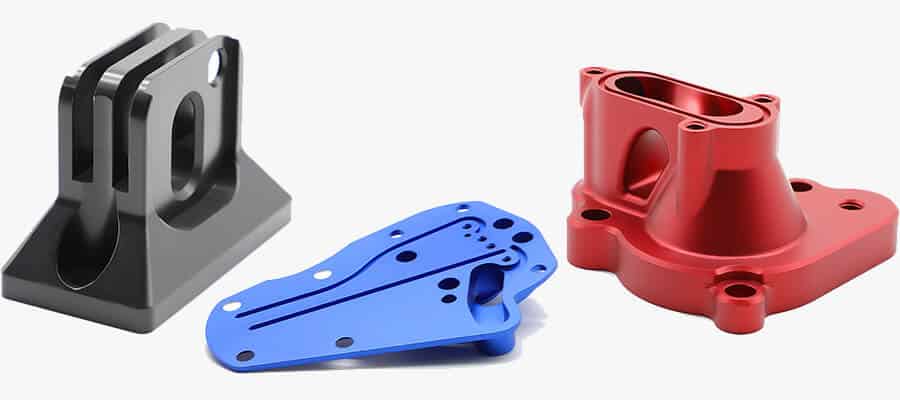
If you’re seeking out dependable and reliable surface finishing services, Runsom Precision is the ideal solution. We provide comprehensive in-house finishing services and can offer you the best surface treatment solution tailored to your needs.
In addition to surface treatments, we also specialize in CNC machining services. This means that if you require Aluminum CNC Machining Service and secondary finishing operations for your CNC machined aluminum products, you can experience a comprehensive machining process. Explore our one-stop services by receiving an instant quote today!
Other Articles You May Be Interested in:

